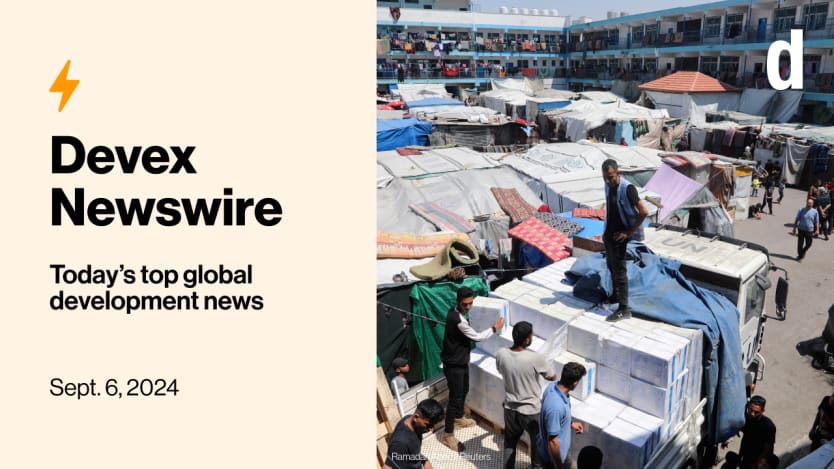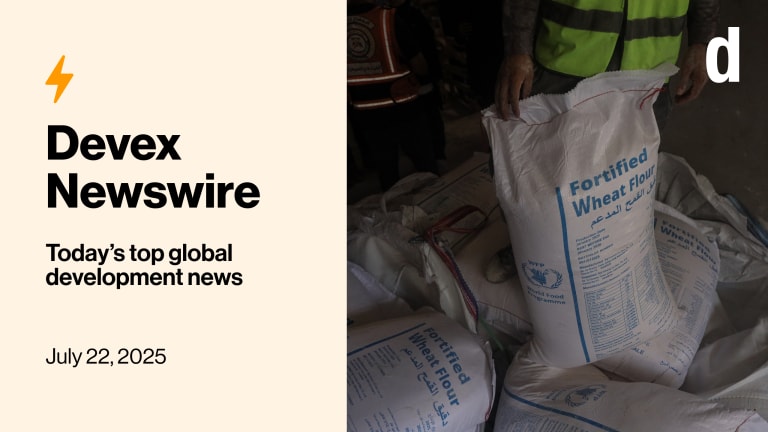
Traumatic experiences, poor leadership, and lack of resources are driving emotional exhaustion in the humanitarian sector. Urgent systemic changes are needed to prevent workers from quitting in droves.
Also in today’s edition: Genetic diversity in wild wheat may hold the key to preventing crop disease, the Pacific islands get on board with a U.S. climate-resilient initiative, and we crunch the numbers on which donors back multilaterals.
+ Up for a quick challenge? Take our five-item monthly news quiz!
Going down in flames
This puts worker burnout into context: It’s a real problem and something we probably don’t consider when facing our own office stresses and strains. Burnout among aid workers can cost them their lives.
This is a preview of Newswire
Sign up to this newsletter for an inside look at the biggest stories in global development, in your inbox daily.
That led Kate Roberts to make a life-changing decision to leave humanitarian work. Despite her efforts providing psychosocial support to those affected by Syria's civil war, she felt unheard and ineffective, leading to emotional exhaustion. Burnout, a common issue among aid workers, often stems from a combination of witnessing extreme crises and unsupportive organizational cultures.
A study of 600 aid workers led by Médecins Sans Frontières’ Kaz de Jong revealed that 75% of surveyed aid workers experienced traumatic events, but it’s often organizational failures — like lack of resources, poor leadership, and job insecurity — that drive burnout. Roberts, now running her own consulting firm for aid worker well-being, echoes this sentiment: A lack of support within organizations can diminish the meaningfulness of the work, leading to emotional distress.
As crises like those in Gaza, Sudan, and Haiti intensify, aid workers carry an emotional burden, with many facing life-threatening risks. Studies show that burnout is exacerbated by workplace stressors like poor job security, sexual harassment, and overwhelming workloads, which contribute more to burnout than the inherent risks of aid work.
Aid workers have increasingly become a target themselves, writes my colleague Elissa Miolene. The number of humanitarian staff killed more than doubled from 2022 to 2023, with 261 lives lost last year alone, according to the aid worker security database. This year’s death toll has moved at a similar pace, with 187 deaths registered as of Aug. 30. Nearly 65% of those deaths have occurred in the Gaza Strip alone.
Experts like de Jong and psychologist Cheryl Yunn Shee Foo argue that addressing burnout requires systemic changes — better management, improved mental health resources, and fostering supportive organizational cultures.
“You can be in, for instance, South Sudan, and see that you’re doing good work,” says de Jong, who is a mental health adviser. “But if you have a lousy organization around you that doesn’t give you the resources, or a project coordinator who is bullying you, there comes a moment when you’re going to say: ‘Hm. This is not meaningful for me anymore. What am I doing here?’ That meaningfulness is really important, and as an organization, you have tremendous influence over that.”
Read: Burnout is hitting humanitarians — but not for the reasons you'd think (Pro)
+ Listen: In the latest episode of our weekly podcast series, Devex’s Raj Kumar, Anna Gawel, and Adva Saldinger further dissect the aid sector’s burnout and staff retention problems and other top global development stories from the week.
Growing resilience, one crop at a time
The Vision for Adapted Crops and Soils is expanding to the Pacific islands. Backed by a $2.6 million investment from the U.S. and Australia — and led by the U.S. State Department — VACS aims to build resilient food systems by focusing on climate-adapted crops and healthy soils. The Pacific Community, a development organization representing 22 regional countries, will lead the initiative, writes Elissa.
With the region facing severe climate impacts and high rates of noncommunicable diseases like obesity and diabetes, VACS will leverage local knowledge and traditional crops to improve food security. The Pacific Community's gene bank, which holds over 2,000 crop samples, will play a central role, alongside research into crop resilience and nutritional value.
“We’ve got a good idea of what the climate change impacts are likely to do to our crops as far as production: We know we have to prepare for more salt in the soil, and we know we have to prepare for longer drought periods,” says Karen Mapusua, director of land resources at the Pacific Community. “But we don’t know what the change in climate is going to do to the nutritional value of our crops, so there’s a big gap there.”
VACS will focus on underutilized crops like breadfruit and diverse banana varieties to boost climate resilience and address nutritional gaps, using a whole-systems approach that could benefit the Pacific and beyond.
Read: Pacific islands join US climate-resilient crops initiative
Wild genetics
Genetic diversity in wild wheat varieties could be crucial for preventing crop diseases, enhancing climate resilience, and reducing agricultural emissions, according to a new study by the International Maize and Wheat Improvement Center, aka CIMMYT, that was published in the Global Change Biology journal.
Although only a small portion of wild wheat genetics has been utilized, it has already improved heat and drought tolerance, disease resistance, and productivity, adding an estimated $11 billion in value.
The study emphasizes the untapped potential of wild crop relatives in modern breeding programs. While breeders have historically been reluctant to use these ancient varieties due to cost and complexity, advancements in genome sequencing and satellite data are now making it easier to explore their genetic potential. However, funding remains a barrier, as donors tend to prioritize academic research over long-term breeding programs.
Without increased support, experts like Matthew Reynolds, co-author of the study and head of wheat physiology at CIMMYT, warn that global food security could be at risk, especially with the need to produce 50%-60% more food by 2050.
“I’m extremely optimistic that we can solve most of the problems that the environment will throw at us,” he says. “But from what I’ve witnessed to date, I’m not optimistic that the status quo will change in time.”
Read: How ancient wild relatives of wheat could safeguard our food supply
ICYMI: Could ancient grains hold answers to Britain's wheat crisis?
+ For the inside track on how agriculture, nutrition, sustainability, and more intersect to remake the global food system, sign up for Devex Dish, our free, Wednesday newsletter.
Shifting aid trends
Since the League of Nations' formation in 1920, intergovernmental bodies have become essential to global development, relying heavily on contributions from wealthy donors. We know from past studies that changes in policies can disrupt these organizations’ operations and projects.
So our analysis, put together by my colleague Miguel Antonio Tamonan, delves into OECD data from 2018-2022 and focuses on which Development Assistance Committee member countries spent the most on multilateral aid and which intergovernmental bodies received the largest support. Here’s some of what we found:
• Official development assistance, or ODA, is disbursed via two main channels: bilateral aid, given directly to recipients, and multilateral aid, provided as core contributions to intergovernmental organizations. “Bi-multi” aid, where donors direct multilaterals to implement specific projects, is considered bilateral aid.
• Between 24%-30% of ODA in the period was multilateral aid, peaking at $53.4 billion in 2021. Bi-multi aid saw significant growth, increasing by 88.7% during this period, while core contributions rose 10.5%.
• The U.S. and Germany led in both core contributions — $33.9 billion each — and bi-multi aid. Slovakia had the highest percentage of ODA allocated to multilaterals, with 76.6%.
• Top recipients: The largest recipients were the European Union development budget, with $59.3 billion, the International Development Association, at $36.5 billion, and the Global Fund to Fight AIDS, Tuberculosis and Malaria, with $21.6 billion.
What does this mean? While multilateral aid plays a crucial role in global development, the growing reliance on bi-multi aid reflects a shift in how donors prefer to control their funds. Expanding multilateral investments and ensuring sustained funding is vital to address global challenges like health, poverty, and climate change.
Read: Which donors back which multilaterals? (Pro)
+ Not yet a Devex Pro member? Start your 15-day free trial today to access all our exclusive reporting and analyses, members-only events, career resources, and the Weekender — a special Sunday newsletter covering our industry’s big moves for Pro members.
In other news
Uganda secured over $600 million in funding from the World Bank and French Development Agency to improve infrastructure and waste management in its capital, Kampala. [Reuters]
U.S. Secretary of State Antony Blinken announced $45 million in new humanitarian aid and supported extending the U.N.-backed mission to combat gang violence in Port-au-Prince, Haiti. [VOA]
German Foreign Minister Annalena Baerbock announced a €50 million ($55 million) aid boost for Gaza, targeting hunger, food insecurity, and health services, during talks in Amman, Jordan. [DPA via Yahoo News]
Sign up to Newswire for an inside look at the biggest stories in global development.








